Benedict Garman,
Emma Pengelly and
Matt Murphy,BBC Verify
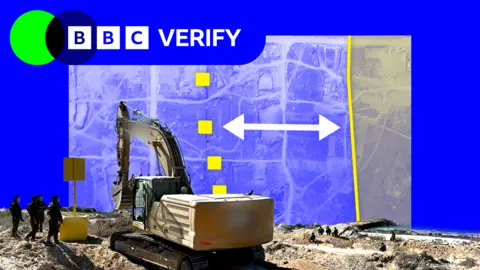 BBC
BBCThe Israeli military is exerting control over more of Gaza than expected from the ceasefire deal with Hamas, a BBC Verify analysis has found.
Under the first stage of the deal, Israel agreed to retreat to a boundary running along the north, south and east of Gaza. The divide was marked by a yellow line on maps released by the military and has become known as the “Yellow Line”.
But new videos and satellite images show that markers placed by Israeli troops in two areas to mark the divide have been positioned hundreds of metres deeper inside the strip than the expected withdrawal line.
Israeli Defence Minister Israel Katz – who instructed troops to place the yellow blocks as markers – warned that anyone crossing the line “will be met with fire”. There have already been at least two deadly incidents near the boundary line.
The Israel Defense Forces (IDF) did not address the allegations when approached by BBC Verify, stating simply that: “IDF troops under the Southern Command have begun marking the Yellow Line in the Gaza Strip to establish tactical clarity on the ground.”
There has been a consistent lack of clarity as to where exactly the boundary will be imposed, with three separate maps posted by the White House, Donald Trump and the Israeli military in the run up to the ceasefire agreement which came into force on 10 October.
On 14 October the IDF issued the latest version marking the Yellow Line on their online map, which is used to communicate its position to people in Gaza.
But in the north, near the al-Atatra neighbourhood, drone footage from the IDF showed that a line of six yellow blocks were up to 520m further inside the Strip than would have been expected from the IDF maps.
Footage geolocated by BBC Verify showed workers using bulldozers and diggers to move the heavy yellow blocks and place them along the coastal al-Rashid road.
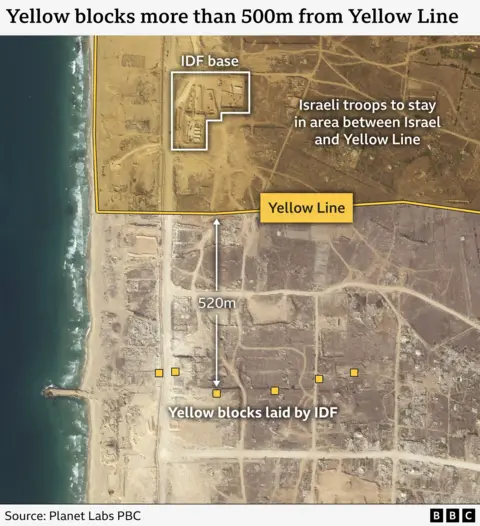
A similar situation was visible in southern Gaza, where a satellite image taken on 19 October showed 10 markers erected near the city of Khan Younis. The line of blocks ranges between 180m-290m inside the Yellow Line set out by the IDF.
If these two sections of boundary were typical of how the markers were being placed along the entirety of the line then Israel would be exerting control over a notably larger area than expected from the ceasefire agreement.
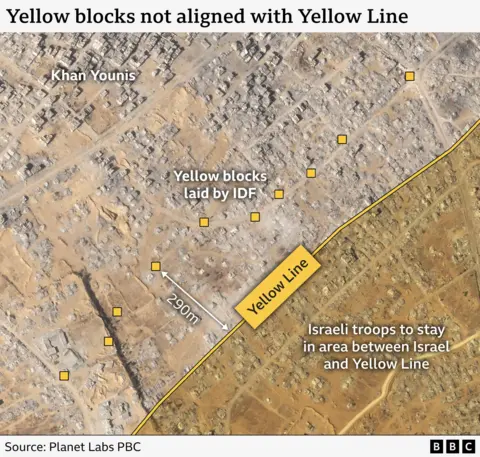
Multiple analysts who spoke to BBC Verify suggested that the blocks were intended to create a “buffer zone” between Palestinians and IDF personnel. One expert said the move would be consistent with a long-term “strategic culture” which seeks to insulate Israel from nearby territories it does not fully control.
“This gives the IDF space to manoeuvre and create a ‘kill zone’ against potential targets,” Dr Andreas Krieg, associate professor at King’s College London, said.
“Potential targets can be engaged before they reach the IDF perimeter. It is a bit like no man’s land that does not belong to anyone – and Israel tends to take that territory from the opponent’s chunk not its own.”
Three experts who spoke to BBC Verify suggested that the disparity between the markers and the IDF map was an intentional design to warn civilians they are “approaching an area of increased risk”.
Noam Ostfeld, an analyst with the risk consultancy Sibylline, said that some blocks “seem to be positioned near roads or walls, making them easier to spot”.
But a post to X by the Israeli defense minister seemed to suggest that the yellow blocks marked the actual line, warning that “any violation or attempt to cross the line will be met with fire”.
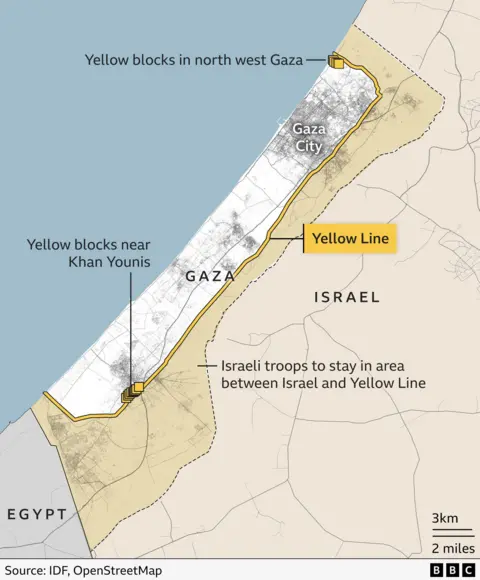
There is already confusion among Gazans over areas where it is safe to go.
Abdel Qader Ayman Bakr, who lives near the temporary boundary in the eastern part of Gaza City’s Shejaiya district, told the BBC that, despite promises from Israel of clear markings, he had seen none put in place.
“Each day, we can see Israeli military vehicles and soldiers at a relatively close distance, yet we have no way of knowing whether we are in what is considered a ‘safe zone’ or ‘an active danger zone’,” he said.
“We are constantly exposed to danger, especially since we are forced to remain here because this is where our home once stood.”
Since the ceasefire came into effect, the IDF has reported a number of instances of people crossing the Yellow Line. On all occasions the IDF said it fired upon those involved.
BBC Verify has obtained and geolocated footage showing the aftermath of one incident on 17 October, which the Hamas-run Civil Defence agency said killed 11 civilians – including women and children all reportedly from the same family. The agency said the Palestinians’ vehicle was targeted by Israel after crossing the Yellow Line east of Gaza City in the Zeitoun neighbourhood.
The footage showed rescue workers inspecting the burnt out remnants of a vehicle and covering a nearby badly-mangled body of a child with a white sheet. BBC Verify geolocated the video to a spot around 125m over the Yellow Line marked on maps by the IDF.
The IDF said warning shots were fired towards a “suspicious vehicle” that had crossed the line. The statement added when the vehicle failed to stop troops opened fire “to remove the threat”.
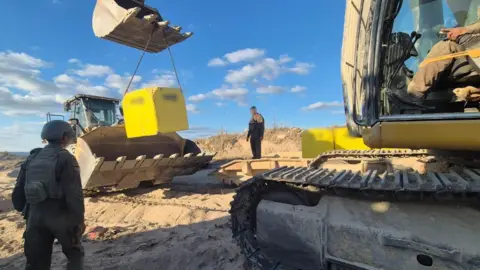 Israel Defense Forces (IDF)
Israel Defense Forces (IDF)Meanwhile, the legal status of the boundary has also been questioned.
“Israel’s obligations under the law of armed conflict do not cease even for those breaching the Yellow Line,” said Dr Lawrence Hill-Cawthorne, professor of Public International Law at the University of Bristol.
“It can only target enemy fighters or those directly participating in hostilities, and in so doing it must not cause excessive civilian harm.”
In a statement, an Israeli military spokesperson said: “IDF troops under the Southern Command continue to operate to remove any threat to the troops and to defend the civilians of the State of Israel.”
They added that the concrete blocks are “being placed every 200 metres”.
Israel launched a military campaign in Gaza in response to the 7 October 2023 attack, in which Hamas-led gunmen killed about 1,200 people and took 251 others as hostages.
At least 68,280 have been killed in Israeli attacks in Gaza since then, according to the territory’s Hamas-run health ministry.
Additional reporting by Erwan Rivault, Lamees Altalebi and Maha El Gaml


